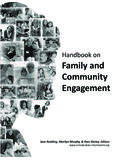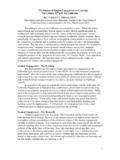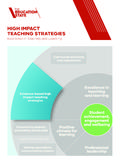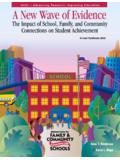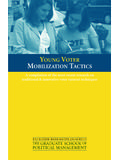Transcription of Handbook on Family and Community Engagement
1 Handbook onFamily and Community EngagementSam Redding, Marilyn Murphy, & Pam Sheley, Editors Handbook on Family and Community Engagement was created with funding and support from the Department of Education s Office of Elementary and Secondary Education to the Academic Development Institute and the Center on Innovation & Improvement. The Center on Innovation & Improvement is a national content center supported by Department of Education s Office of Elementary and Secondary #S283B050057 Academic Development Institute / Center on Innovation & Improvement121 N. Kickapoo StreetLincoln, IL opinions expressed herein do not necessarily reflect the position of the supporting agencies, and no official endorsement should be inferred. 2011 Academic Development Institute. All rights : Stephen Page, Robert Sullivan, & Lori ThomasDesign: Michelle Schneider & Pam SheleyHandbook onFamily and Community EngagementSam Redding, Marilyn Murphy, & Pamela Sheley, EditorsAcknowledgementsThe editors acknowledge the support and guidance provided us by the Department of Education, especially Carl Harris, Patricia McKee, Gary Rutkin, Danita Woodley, and Fran Walter, for the creation of this Handbook .
2 The timely and competent editing by Robert Sullivan, Lori Thomas, and Stephen Page resulted in a published version worthy of the expert contributions of the authors. Especially, the editors shower their appreciation on the authors, all scholars of high merit devoted to families, schools, and communities and cheerful in meeting the project s expectations and deadlines. iiiForewordFor a half-century, we have labored in the light of the Coleman Report s finding that families and communities strongly affect children s school success, our work inspired by the belief that these influ-ences are malleable. Improving America s schools takes different paths in turn, as research and expe-rience reveal promising organizational structures and professional practices. Always, Family and Community Engagement receives a rhetorical bow, even as we have often tackled this work with uncer-tainty, sporadic attention, and sometimes disappointing results.
3 The knowledge, wisdom, and insights of this volume s contributors reflect the accumulated lessons learned by people who walk different paths in pursuit of a common vision that all children might benefit from schools, families, and communities united in their behalf. Finding the right chemistry for relationships among school personnel, families, and Community members remains a vision not entirely achieved. Our hope is that this Handbook will bring us closer to the realization of that vision. Our desire in preparing this Handbook was to bring together the best minds on the various topics related to Family and Community Engagement and produce a guidebook that is solid in its research footings, practical in its presentation, and useful to people in the field. To touch hearts as well as minds, we have sprinkled throughout the book several fictional vignettes to remind us of the everyday lives of parents, teachers, and the children they hold in their care.
4 This Handbook is intended to provide educators, Community leaders, and parents with a succinct survey of the best research and practice accumulated over the years. More important, the Handbook gives us a guide a lean and lucid roadmap with which we can travel to a new plain in our quest for each and every student s academic, personal, social, and emotional development. We offer the Handbook as a skeleton on which the body of good work in the field can be built. That work is extensive, and the people engaged in it are a special breed, firm in their commitment to enhancing the opportunities for our youth and wise in their understanding that schools cannot provide that opportunity alone. ivvTable of ContentsForeword ..iii Sam ReddingIntroduction ..vii Helen WestmorelandPart I: Framing the DiscussionNew Directions for Title I Family Engagement : Lessons From the Past.
5 3 Oliver C. Moles, Jr. & Arnold F. FegeThe School Community : Working Together for Student Success ..15 Sam ReddingMaking Data Matter in Family Engagement ..21 Heather Weiss & M. Elena LopezEngaging Families and Communities in School Turnarounds: When Students Can t Wait ..29 Lauren Morando RhimSocial, Emotional, and Academic Learning: Complementary Goals for School Family Partnerships ..37 Amy Mart, Linda Dusenbury, & Roger P. WeissbergEngaging the Entire Community : The Community Schools Way ..45 Marty BlankPart II: Families and LearningAspiration and Expectations: Providing Pathways to Tomorrow ..57 William Jeynes Vignette: Jessica William Jeynes ..60 Self-Efficacy: Up to the Challenge ..61 Kathleen Hoover-DempseyCurriculum of the Home ..69 Herbert J. Walberg Vignette: Annabelle Marilyn Murphy ..75 Homework and Study Habits ..77 Lee Shumow Vignette: Tyler Lee Shumow.
6 80 Engaging Families in Holly Kreider Vignette: Xiomara Georganne Morin & Holly Kreider ..85 Reading and Literacy ..87 Diana Hiatt-Michael Vignette: Alicia and Dan Diana Hiatt-Michael ..91 College and Career Readiness ..93 Mary R. Waters & John Mark WilliamsviPart III: Families and SchoolsA Framework for Partnerships ..99 Steven B. SheldonParent Leadership ..105 Anne T. Henderson & Sam ReddingMaximum Homework Impact: Optimizing Time, Purpose, Communication, and Collaboration ..109 Frances Van VoorhisDifferentiating Family Supports ..113 Patricia Edwards Vignette: Angela Patricia Edwards ..116 Bridging Language and Culture ..117 Patricia G ndaraMinority Families and Schooling ..121 Susan J. PaikAssociation of Poverty With Family Relations and Children s and Adolescents Socioemotional Adjustment ..125 Ronald Taylor Vignette: Billy Sam Redding ..129 Families of Children With Disabilities: Building School Family Partnerships.
7 131 Eva Patrikakou Vignette: Tony Lori G. Thomas ..135 Linking Schools to Early Childhood ..137 Kate McGillyFamily Engagement in High Schools ..141 Mavis SandersFamily and Community Engagement in Charter Schools ..147 Brian R. Beabout & Lindsey B. JakielFamily Engagement in Rural Schools ..153 Amanda L. Witte & Susan M. SheridanBridging Two Worlds for Native American Families ..157 Pamela Sheley Vignette: Marie Pamela Sheley ..161 Part IV: Suggested PracticesChecklist of Suggested Practices ..165 Sam ReddingAbout the Authors ..179 IntroductionHelen WestmorelandA key takeaway from these chapters is that there is a need for schools to create collaborative and coordinated systems for Family and Community HandbookxThis Handbook offers a broad definition of Family and Community Engagement , seen through the lens of scholars and practitioners with a wide-ranging set of perspectives on why and how families, communities, and schools collaborate with one another.
8 Taken together, the chapters in this Handbook sketch out the components of a theory of change for the Family and Community engage-ment field. What is Family and Community Engagement ultimately in service of? What do families know and do differently when this work is successful? What educational policies and practices will help us realize these changes?Throughout the chapters, we learn about the many goals and purposes of Family and commu-nity Engagement . In chapter 4, Lauren Morando Rhim argues that it should be used as a strategy to turnaround low-performing schools. Family and Community Engagement builds social capital and Community , as well as provides additional resources and opportunities for young people, as Marty Blank points out in his description of Community schools in chapter 6. In addi-tion to these ecological or collective changes, Family and Community Engagement also serves to impact individual students.
9 As Amy Mart, Linda Dusenbury, and Roger Weissberg describe in chapter 5 and other contributors underscore, it helps promote students social, emotional, and academic learning. Ultimately, it predicts students college or career readiness, as Mary Waters and John Mark Williams point out in chapter 13. Whether through improved relation-ship skills, higher achievement, or better school or life transitions, students benefit when fami-lies, communities, and schools work together on their behalf. In order to fulfill these visions, the contribu-tors in this Handbook articulate a range of home and Community outcomes which need to be addressed in Family and Community engage-ment efforts. As Herbert Walberg argues in chap-ter 9, influencing the curriculum of the home, including all the roles parents play to support learning, is crucial to supporting student suc-cess.
10 For example, in chapter 7, William Jeynes points out that we must increase families capac-ity for more subtle forms of Engagement , which fosters a Family culture of high expectations, to have the largest impact student achievement. Holly Kreider and Diana Hiatt-Michael, in chapters 11 and 12, respectively, summarize the importance of engaging Family and Community members in structured reading and literacy-promoting activities with children. Parents learning support strategies at home also include monitoring and helping with homework, as Lee Shumow and Francis van Voorhis describe in chapters 10 and 16, chapter 1, Oliver Moles and Arnold Fege illuminate the tension in federal Family and com-munity Engagement legislation of seeing families as individuals versus as a collective group of citi-zens that helps improve schools and holds them accountable. Speaking to the collective power of parents, in chapter 15 Anne Henderson and Sam Redding highlight how parent leaders engage in decision-making, organizing, engaging other parents, educating stakeholders, and advocating and connecting for change.

